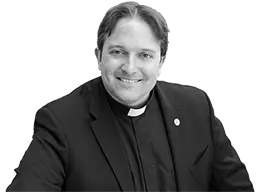 Fr Matthew Charlesworth SJJesuit PriestSociety of JesusJesuit priest working in Southern AfricaFr. MatthewCharlesworthSJ
Fr Matthew Charlesworth SJJesuit PriestSociety of JesusJesuit priest working in Southern AfricaFr. MatthewCharlesworthSJ
 Tuesday of the 4th Week of Lent
Tuesday of the 4th Week of Lent
Date: | Season: Lent | Year: C
First Reading: Ezekiel 47:1–9, 12
Responsorial Psalm: Psalm 46:2–3, 5–6, 8–9
| Response: Psalm 46:8
Gospel Acclamation: Psalm 51:12a, 14a
Gospel Reading: John 5:1–16
Preached at: the Chapel of the Most Holy Name, Kolvenbach House in the Archdiocese of Lusaka, Zambia.
There is a scene, beautifully portrayed in The Chosen (Season 2, Episode 4), that captures the moment when Jesus encounters the man at the pool of Bethesda. It is haunting in its realism. The man—Jesse, as the show names him—has been lying there for nearly four decades, watching others step into the waters while he remains trapped by his affliction. He has no one to help him, no strength to move himself, no hope left. And then Jesus appears.
The moment is almost jarring. Jesse expects pity, maybe indifference, but not this—Jesus locks eyes with him and asks, “Do you want to be healed?” It is a question that cuts through the layers of disappointment, bitterness, and resignation that have built up over the years. Jesse stammers, explaining why he cannot be healed, recounting his helplessness as though it were a badge of identity. But Jesus interrupts: “I didn’t ask who is helping you. I asked, do you want to be healed?” And then, with quiet but undeniable authority, He tells him, “Get up, pick up your mat, and walk.”
And he does.
Imagine the shock—the trembling disbelief as his body, atrophied by years of stillness, suddenly surges with strength. Imagine the tears, the gasp of joy, the staggering first steps into a life that had seemed forever lost. Yet, remarkably, as The Chosen highlights, Jesse does not immediately grasp what has happened. He is still carrying his old wounds in his mind, even though his body has been restored. The external healing is undeniable—but the deeper, spiritual healing is still unfolding.
And isn’t that true for us? How often do we sit by our own Bethesda, paralyzed not by broken limbs but by fear, by sin, by wounds we have allowed to define us? How often do we explain away our stagnation, as if the burdens we carry are excuses for not moving forward? The question Jesus asks Jesse is the question He asks us: Do you want to be healed? Not just physically, but spiritually, emotionally, wholly.
Lent is a season where Christ walks among us with that same piercing question. We may have grown accustomed to our infirmities—our addictions, our grudges, our despair—so much so that healing seems foreign, almost frightening. But Jesus does not offer empty sentiment; He commands action. He calls us to rise, to take up the very burdens we thought defined us and walk into new life.
Yet, the Gospel does not end there. Jesse’s healing sparks controversy. The religious authorities do not celebrate his restoration; instead, they fixate on the fact that he is carrying his mat on the Sabbath. Rules and regulations, even good ones, have become more important to them than the reality of God’s mercy at work. How often do we see this in our own world? Where legalism suffocates love, where institutions cling to power instead of serving the poor, where we judge others’ redemption rather than rejoicing in it?
This is not just a first-century problem. In Zambia today, how often do we see people bound by structures that should serve them but instead oppress them? How often do we find those who have been healed—whether through education, opportunity, or sheer grace—turned away by a society more concerned with maintaining order than celebrating new life? Do we, like the Pharisees, miss the miracle because we are too fixated on the rules?
The vision of Ezekiel, with its life-giving river flowing from the temple, is a stark contrast to the stagnant waters of Bethesda. God’s mercy is never still. It moves, it expands, it transforms. And He calls us to do the same. The world does not need more gatekeepers of grace—it needs channels through which grace flows freely.
Consider the life of Blessed Rupert Mayer, a Jesuit priest who lived during Nazi Germany. He was a man who could have chosen safety, could have chosen silence. But he did not. He spoke out against injustice, against cruelty, against indifference to the suffering around him. For this, he was imprisoned, sent to a concentration camp, and ultimately silenced. And yet, even from his prison, his witness inspired countless people to courage, to action, to faith. He was a man who, when Christ told him to rise, did so—at great personal cost.
And so, the question returns to us. Will we rise? Will we move beyond our paralysis, whatever form it takes? Will we allow Christ not only to heal us but to make us instruments of healing for others?
Here are three questions we could take into prayer today:
- What is my mat—the burden I carry, the excuse I cling to, the past I refuse to let go of?
- Where have I resisted healing, preferring familiarity over transformation?
- How can I be a source of mercy and justice, ensuring that grace flows freely rather than becoming stagnant?
Jesus stands before us, as He stood before Jesse, as He stands before all who long for healing. The question remains the same: Do you want to be healed? And the command remains unchanged: Rise. Take up your mat. And walk.
In preparing this homily, I consulted various resources to deepen my understanding of today’s readings, including using Magisterium AI for assistance. The final content remains the responsibility of the author.
← Back